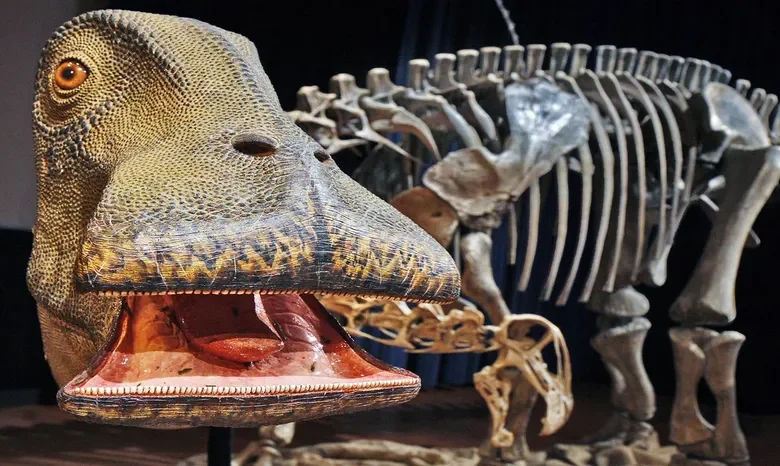What Dinosaur Has 500 Teeth? Unveiling the Secrets of Prehistoric Beasts

Introduction to Dinosaurs and Their Teeth
Dinosaurs have always captured our imagination. These colossal creatures roamed the Earth millions of years ago, leaving behind a fascinating legacy that continues to intrigue scientists and enthusiasts alike. Among their many mysteries, one question stands out: What dinosaur has 500 teeth?
Imagine a creature with an extraordinary dental arsenal, capable of chomping through tough vegetation like no other. The very idea sparks curiosity about how such a dinosaur lived and thrived in its prehistoric world. As we embark on this exploration, we will unveil the secrets hidden within these ancient beasts’ jaws and discover what made them unique in their time. Join us as we delve into the captivating story of this remarkable dinosaur!
The Discovery of the Dinosaur with 500 Teeth
The discovery of the dinosaur with 500 teeth is a fascinating chapter in paleontology. This marvel, known as Nigersaurus, was unearthed in the mid-1990s in Niger’s Sahara Desert.
Paleontologists were astonished to find its unique set of dental features. The sheer number of teeth suggested it had a specialized diet, possibly consisting of soft vegetation.
Excavations revealed impressive fossilized remains, allowing scientists to reconstruct its jaw and skull structure. Each tooth was adapted for grazing on low-growing plants.
Nigersaurus lived during the Late Jurassic period around 110 million years ago. Its remains provided critical insights into how certain dinosaurs evolved their feeding mechanisms.
This groundbreaking discovery opened new avenues for research into herbivorous dinosaurs and their ecological roles within prehistoric ecosystems.
The Name and Characteristics of the Dinosaur
The dinosaur known for having 500 teeth is called *Nigersaurus*. This fascinating creature roamed the Earth during the Late Jurassic period, around 115 to 105 million years ago.
*Nigersaurus* was a sauropod, characterized by its long neck and enormous body. However, what truly sets it apart is its unique dental structure. Its jaws were lined with an impressive array of slender, spoon-shaped teeth.
These specialized teeth were perfect for grazing on low-lying vegetation. Unlike many other dinosaurs that had robust teeth suitable for tearing flesh or tough plant material, *Nigersaurus* adapted to a herbivorous lifestyle with efficiency in mind.
Its lightweight skull allowed it to forage effectively while keeping energy expenditure low. This intriguing adaptation showcases how diverse dinosaur diets could be based on their anatomical features and ecological niches.
Theories on Why it Had So Many Teeth
Scientists speculate on several reasons for the dinosaur’s staggering 500 teeth. One theory suggests that this unique dental arrangement aided in processing a herbivorous diet. The sheer number of teeth may have allowed for better grinding and shredding of tough plant materials.
Another idea points to its feeding strategy. With so many teeth, this dinosaur could capture more food efficiently, maximizing energy intake from available resources. This adaptation would have been vital during times when vegetation was scarce.
Some researchers even propose that the abundance of teeth contributed to social behaviors among these creatures. Teeth might have played roles in mating displays or dominance interactions within their species.
The evolutionary pressures faced by such dinosaurs can reveal insights into their habitats and lifestyles, offering a glimpse into how they thrived during their era. Each tooth tells a story about survival strategies long gone from our world today.
Comparison to Other Dinosaurs with Unique Dental Features
When it comes to unique dental features, dinosaurs were anything but ordinary. Take the iconic Tyrannosaurus rex, for instance. With its powerful jaws and sharp serrated teeth, T. rex was built for tearing through flesh rather than chewing.
Contrastingly, the long-necked Brachiosaurus had a completely different approach to feeding. Its flat-topped teeth resembled a comb, perfect for stripping leaves from tall trees in its lush environment.
Then there’s the duck-billed Edmontosaurus with hundreds of grinding teeth designed specifically for processing tough vegetation. This herbivore thrived on plant matter that required significant chewing power.
Each dinosaur adapted its dental structure based on diet and habitat. Their varied approaches not only reveal their ecological niches but also paint a broader picture of prehistoric life—one rich in diversity and specialization within these fascinating creatures.
The Importance of Understanding Prehistoric Beasts
Understanding prehistoric beasts opens a window into Earth’s distant past. Dinosaurs were not just giant reptiles; they played vital roles in their ecosystems.
Studying these creatures helps scientists grasp evolution and adaptation. Each fossil offers clues about climate changes, habitats, and survival strategies over millions of years.
Moreover, dinosaurs spark curiosity and imagination. They are a gateway to exploring topics like paleontology and geology among children and adults alike.
The more we learn about them, the better we understand our planet’s history—a narrative that continues to unfold today. These ancient giants remind us of the delicate balance of life on Earth.
Gaining insights into prehistoric life allows us to appreciate biodiversity’s importance now more than ever. The lessons learned from studying such magnificent beings shape conservation efforts for current species at risk of extinction.
Conclusion: Unlocking the Mysteries of Dinosaurs Through Their Teeth
Teeth tell a story. They reveal secrets about a dinosaur’s diet, habits, and environment. The discovery of the dinosaur with 500 teeth is a fascinating glimpse into how these ancient creatures adapted to their surroundings.
Understanding why this dinosaur had so many teeth opens doors to numerous questions about its lifestyle and feeding strategies. Did it thrive in an ecosystem teeming with aquatic life? Or was it primarily herbivorous, grinding down tough foliage? Each theory adds layers to our comprehension of prehistoric life.
The study of unique dental features among what dinosaur has 500 teeth not only enriches our knowledge but also highlights the diversity that once existed on Earth. Comparing different species allows scientists to trace evolutionary pathways and understand ecological niches.
Diving deeper into these aspects enhances our appreciation for the intricate tapestry of life that roamed millions of years ago. It ignites curiosity about how organisms evolve over time based on environmental pressures and dietary needs.
As we uncover more fossils and analyze them meticulously, we’re reminded that every tooth holds a piece of history waiting to be revealed. The journey continues as paleontologists strive to unlock more mysteries hidden within the remnants left by these magnificent beasts from long ago.



